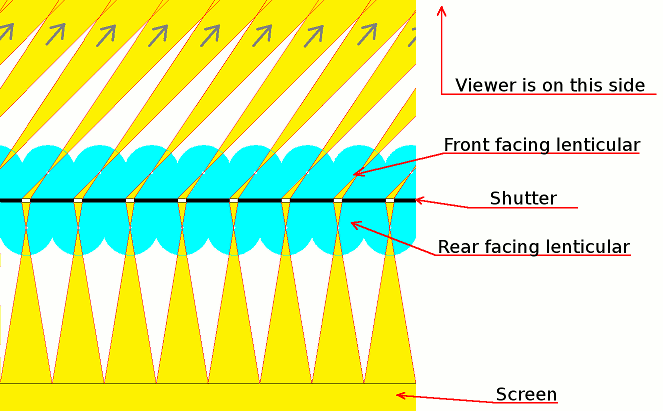3D Tau made a prototype device for demonstration of the SSE technology. The video below shows the prototype capabilities to show multi-angle video.
The prototype is an add-on for a common TV or computer display. The following optical-mechanical device, which is equivalent to the patented one, but with a modified kinematics, consists of:
- An inner lenticular lens together with a slit layer fixed on it is a stationary part;
- An outer lenticular lens (together with a scattering film) is movable and performs all necessary sequential shifting in relation to slits.
The outer lenticular lens is moved by a rotary engine through a crank rod. An encoder designed for manual regulation of the starting position of a lenticular lens is mounted on the engine shaft. The movement of the lenticular lens is implemented on frame-type sliding guides/sled. The engine is set to ensure stable operation at a frequency of ≈ 150 Hz for demonstration under full load (with lenticular lens) for 1-1.5 hours. With acceleration of start-stop cycles (up to 500 Hz) continuous operation of the engine is significantly reduced. Engine control is similar to the layout of a lab design, it is controlled by visual signals coming from the screen (programming/tuning of controller has been managed from the computer). A power supply (for engine and controller) will ensure full autonomy for SSE and its independence from the demonstration device. A computer screen with 144 Hz refresh rate was selected for the prototype.
As in the case of the laboratory sample, the main task of the prototype is exact perspective switching in the spectator area, as shown in the illustration below:

During the demonstration, each angle was separated (in compressed fragments) in fixed slits and instantly directed by lenticular lens to the spectator area. Direction switching was recorded using a camera: constant visual edge-to-edge perspective with the transition to the next perspective number. The device also demonstrated the 3D effect (voluminosity) of image in both static and dynamic forms.
It should be noted that the limited speed qualities of prototype’s optical mechanics, together with low performance of demonstration screen and graphics card, produced the so-called “dark flickering” (from the 4th perspective) of the image in spectators area. Nevertheless, the prototype performs the main tasks.
